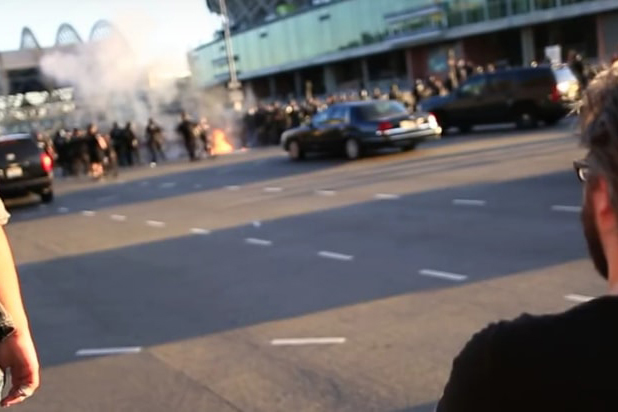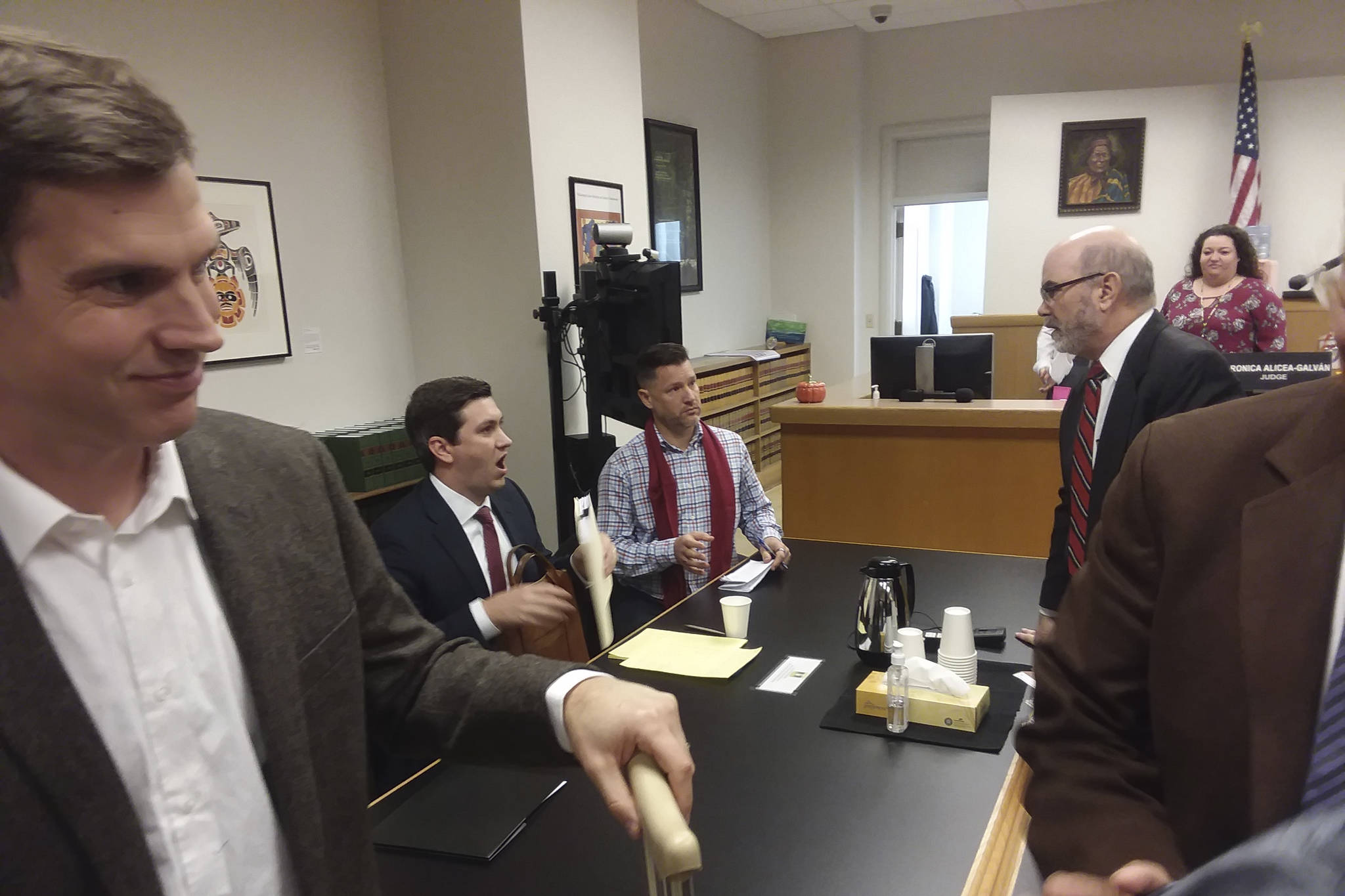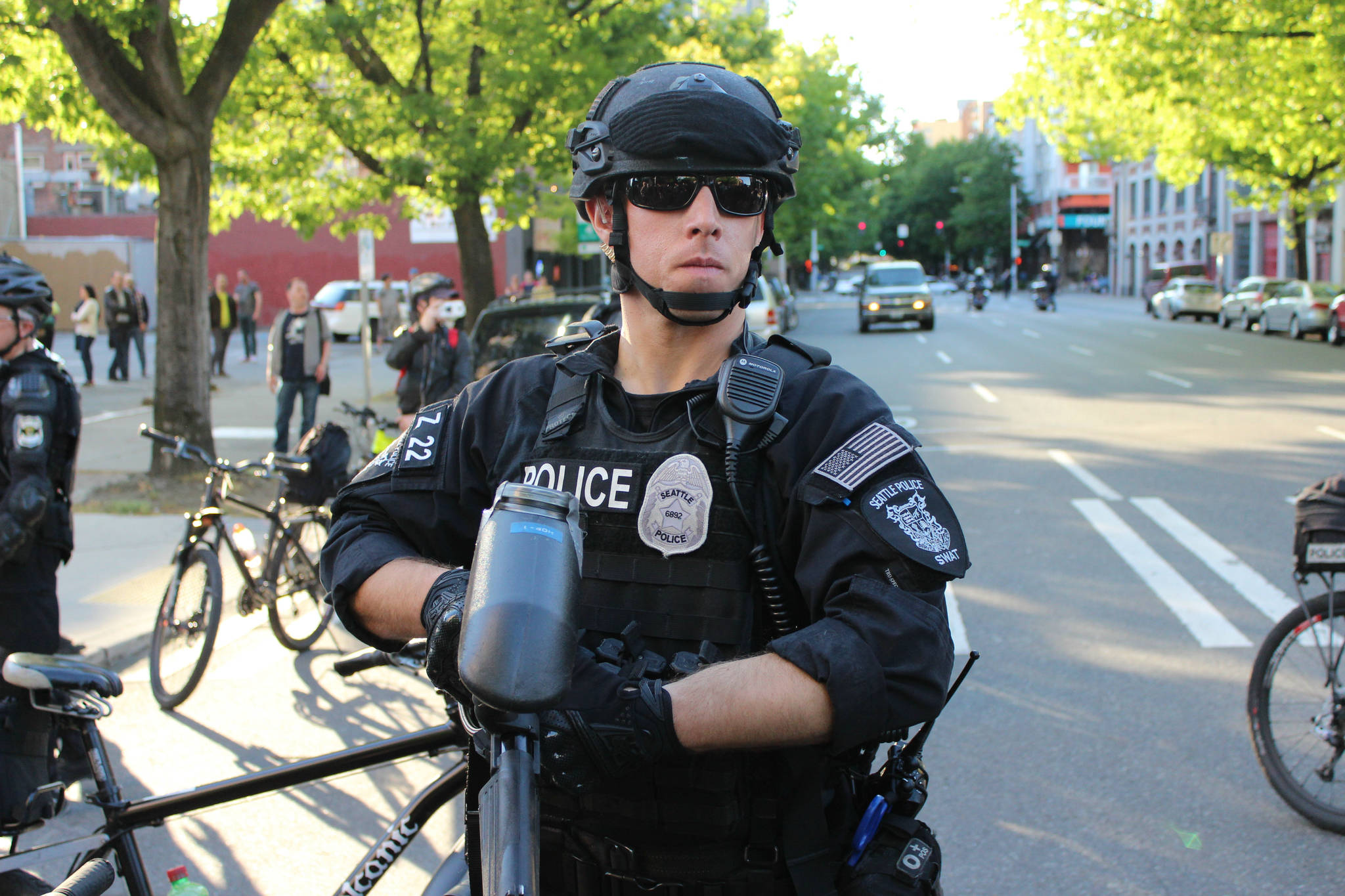This past spring’s May Day anti-capitalist protest in Seattle was, predictably, chaotic. Protesters lobbed heavy objects at police, police lobbed explosive objects at protesters, and by the time it was all over, five officers had been injured, nine protesters arrested, and at least one observer had his face torn open by a police blastball. In many media accounts that followed, the onus of that chaos landed squarely on the protesters’ shoulders, as they have since protesters smashed the window of a federal courthouse (leading then-mayor Mike McGinn to declare a state of civil emergency) in 2012.
But new evidence obtained by Seattle Weekly appears to show that, at least in one case, it was recklessness by police themsleves that harmed at least one officer. Analysis of video collected from May Day’s anti-capitalist march shows that a blastball thrown by Seattle police almost certainly ignited a failed Molotov cocktail, causing an officer to be burned.
The revelation that police very likely ignited the Molotov complicates a media narrative captured in the CNN headline “Seattle May Day protests marred by Molotov cocktails, violence.”
Activist Howard Gale says he’s spent countless hours reviewing video taken during the May 1 march at the intersection of Seattle Boulevard South and Fourth Avenue South. Using video shot from multiple cameras, Gale shows that a fire briefly erupted in the middle of police lines, well after marchers had moved away. The fuel for the fire was an unlit Molotov cocktail that a protester had smashed on the ground before police lines advanced over that location. Gale’s video evidence appears to show that the fuel was ignited by an errant blastball behind police lines. The video does not clear protesters of blame for the burned officer; after all, it was someone in the march who threw the flammable liquid at police to begin with. But the video does complicate the narrative that the march was an example of responsible, restrained crowd control by police.
A Seattle police spokesperson confirms that an officer was burned on the leg at the intersection. (Prior to viewing the video evidence below, that spokesperson said it is possible but “unknown” whether a police blastball caused the fire; we’ll update this post when we get a response from SPD.)
Let’s go through the evidence. First, this video establishes that there was a fire at that intersection right after blastballs explode:
From the 6 to 12 second mark in the above video you see a bearded man wearing a black baseball cap and a blue backpack. That’s me. I tweeted about seeing flames, though my own camera didn’t catch any:
Also saw bricks, glass and plastic bottles, some I think w gasoline (saw fire, heard cop say "gasoline") thrown at @SeattlePD by marchers.
— Casey Jaywork (@CaseyJaywork) May 2, 2016
Now, take a look at Gale’s video analysis.
Gale cites as evidence several videos from journalists and observers who attended the anti-capitalist march on the evening of May 1, 2016. The first was filmed by yours truly, on my shoulder cam. The segment begins with text: “In the first three seconds of the video a bottle is tossed along the pavement, towards the police line, discharging liquid and breaking apart.” That smashed bottle is the source of the fuel puddle that ignites later. At the end of segment, three blastballs detonate in one … one two rhythm, and in the lower left part of the screen a plume of white smoke rises from behind police lines. Two other videos show the same thing from other angles.
The fourth video segment, though, is the clincher. Shot from behind the police line at the same time as the other videos, it shows the third blastball explosion amid police, immediately followed by a fire in the same spot. The original video, below, is much higher resolution than the edited version in Gale’s video, allowing you to clearly see the fire and a police officer extinguishing it. A screenshot from the original video is at the top of this post.
Given this video evidence, it is all but certain that a police blastball inadvertently ignited the puddle of fuel left by an unlit Molotov cocktail.
In the days following May Day, many—including this newspaper—criticized marchers for escalating violence to the point of a Molotov cocktail. “Symbolic or petty violence against riot cops is one thing,” we editorialized. “Earnestly trying to injure them is quite another. Both as residents of Seattle and its chroniclers, we condemn the use of firebombs and heavy projectiles against police.”
The revelation that Seattle police appear to be responsible for igniting a spilled Molotov—the only lit Molotov present at the march, so far as we’re aware—doesn’t negate our condemnation. But it does add urgency to our criticisms of SPD in that same editorial. “Seattle police were wrong on Sunday when they repeatedly launched blast balls into the middle of—not behind or next to, as dictated by SPD training—marchers,” we opined, noting that many people were pepper sprayed for not retreating fast enough. “One ball tore open the face of photojournalist Sam Levine, sending him to ER surgery. … As a small, well-trained army, Seattle police should be held to higher standards of conduct than a motley band of protesters.”
The news that a blastball almost certainly ignited, in the middle of an SPD phalanx, a puddle of fuel is yet one more example of police’s “less lethal” weapons escalating conflict—and harm. It’s a perfect symbol: police igniting something they could have avoided, literally burning themselves as a result.
In an opinionated essay accompanying his video analysis, Gale explains his motivation for doing the analysis. It’s not sympathy with the marchers, the most aggressive of whom he calls “narcissistic nihilistic fundamentalists.”
Those anti-capitalist marchers, he writes, “are still our fellow citizens due all Constitutional rights and protections. Period. No qualifications. When the police take—or are given—license to abuse the rights and physical safety of obnoxious confrontational shitheads, they will inevitably use that power against obnoxious confrontational saints. It is more of the later that has made our country better. And even shitheads can become saints (at least those that don’t become capitalists).”
Gale is concerned that unchecked tales of black bloc marchers flinging firebombs at police will be used to justify harsher policing. “We do not want to find ourselves having circular debates in the future, where the threat of Molotovs is used to justify the use of blast balls or other ‘less-than-lethal’ weapons by the police,” he writes.
UPDATE: Seattle police spokesperson Sgt. Sean Whitcomb has responded to the video evidence presented in this article. He says he’s still not convinced. “For me, I’m not seeing any clear answer to the question” of whether the blastball ignited the fire, he says. “It’s impossible to move beyond speculation to reach conclusion, for me. I just don’t think it’s definitive.” Whitcomb says he still thinks it’s possible that a firework from the crowd ignited the puddle of fuel.
“We certainly haven’t ruled out the possibility that it was a blastball,” he says.
UPDATE: Twitter user @GeorgetownMike has more video of the conflagration.








